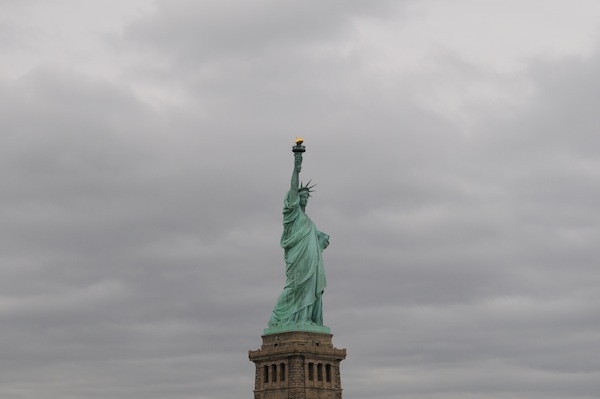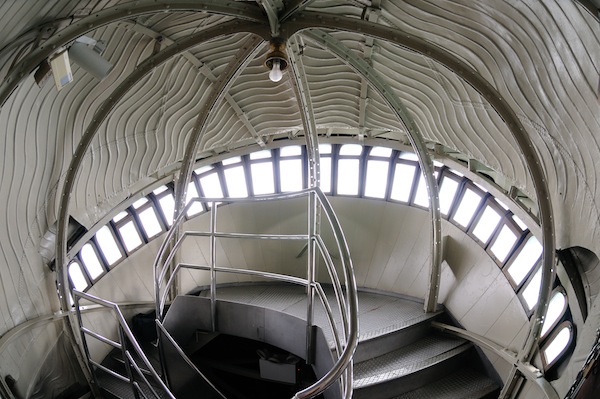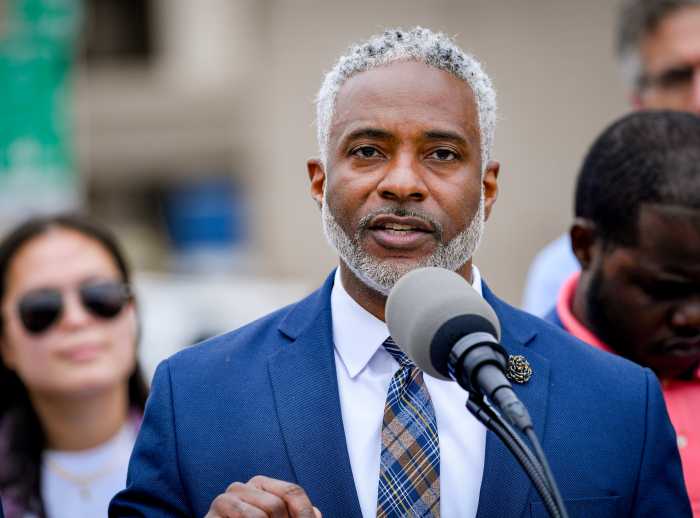
BY TERESE LOEB KREUZER | With the imminent arrival of Hurricane Sandy contributing glowering skies to the festivities, the interior of the Statue of Liberty reopened on Sunday following a year of renovations.
The reopening ceremony took place the day before the subways shut down. It was the 126th anniversary of the statue’s dedication, with West Point cadets, Secretary of the Interior Ken Salazar and David Luchsinger, the superintendent of the Statue of Liberty National Monument and Ellis Island participating. Salazar and several cadets were the first to ascend to the crown. They were followed by 200 members of the public who had snagged tickets for the opening day.
Access to the interior of the statue much less the crown has been intermittent for more than a decade. After the destruction of the World Trade Center on Sept. 11, 2001, Liberty Island was completely closed to the public. Access to the island resumed on Dec. 20 but both the statue and the pedestal remained closed. In 2004, the public was allowed inside the pedestal but not to the statue’s crown.

The Princeton, N.J. firm of Mills + Schnoering Architects, which had previously worked on the crown, was commissioned to come up with a design for the installation of three elevators and two fire-code-compliant stairs. For the first time, an elevator now enables people with mobility impairments to go the observation deck on the sixth level of the pedestal. A separate elevator big enough for two people now goes from that level to the shoulder of the statue in case of a medical emergency that would require evacuation. The renovation also includes air conditioning in the crown and improved bathroom facilities.
The open, double-helix stairs that lead to the crown were originally only for the very adventurous. Now they have been equipped with high bannisters to give people something to hold onto as they climb.

Michael Mills, the chief architect for the renovation, remembered his first trip to the statue’s crown when he was in high school. “I was kind of awed by it and scared by it,” he recalled. “I didn’t feel safe but I enjoyed it and I felt a sense of accomplishment that I actually did it.” Now, he said the 315 people a day who go up to the crown will feel a lot safer.
Mills said that the contractor for the renovation, the firm of Joseph A. Natoli Construction Corporation, faced the challenge of building a project of this magnitude on an island in New York harbor. In addition to getting materials out to the island, “There were security issues,” he said. “Everything had to be checked by dogs and by the guards. It was just amazing how they managed to do it.”
For his firm, he said the biggest challenge of the renovation was having to work in a tight space. The pedestal at its widest is 27 feet by 27 feet and is crisscrossed by a support structure designed in the 19th century by Gustave Eiffel, the famed engineer who also designed the Eiffel tower in Paris.
“We had to figure out a way to get an elevator straight up through the Eiffel structure without touching it and get two independent stairs up through that crisscross of beams,” said Mills. He said that for the first time on any of its projects, his firm used three-dimensional computer modeling.
“The model enabled us to see things that we wouldn’t have seen,” he said. “There was one location where Stair B coming down from the top had a conflict with Stair A at a landing. We didn’t notice it in a floor plan or even in an elevation but in a model all of a sudden it appeared so we had to modify the design. To do something like that during construction is very expensive. You don’t want to do that.”
The new fire stairs are enclosed from each other but are also open so that visitors can appreciate the historic fabric of the pedestal. Eiffel used beams to support the statue reinforced by iron straps that run through the pedestal. “It wasn’t just the weight of the statue [that was a problem],” Mills said. “It was the wind and the overturning potential that they had to resist.”
On Oct. 29 Hurricane Sandy roared through New York harbor. Both Liberty and Ellis Islands suffered flood damage and are temporarily closed. However, the Statue of Liberty withstood the punishing winds, once again demonstrating Eiffel’s genius.




































